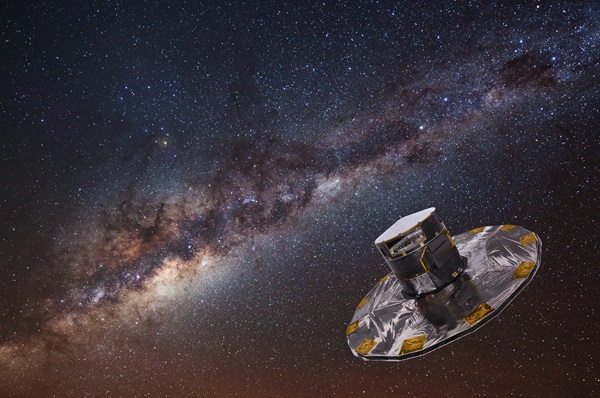Key Takeaways:
Among the most intriguing results stemming from the recently released Gaia data are: the discovery of a supernova-propelled white dwarf zipping through the Milky Way at a steady clip of 5 million miles per hour; a 12-billion-year-old supermassive black hole that is devouring mass faster than any other black hole ever found; and nearly 14,000 white dwarfs, some of which likely formed through mergers, all located within a few hundred light-years of Earth.
So long supernova
In a new study posted April 30 on the preprint site arXiv, a team of researchers presented measurements for three of the fastest known stars in the Milky Way, each of which is likely a previous white dwarf companion to a star that exploded as a Type Ia supernova. Thanks to Gaia’s incredible ability to track the motions of stars, the researchers were able to rewind the tape on these hypervelocity white dwarfs, all of which travel faster than 2 million miles (3.5 million kilometers) per hour. When they traced back the motions of the white dwarfs, they even found that one originated from a faint, old supernova remnant, bolstering its case as a hypervelocity runaway from a binary system that was subjected to a supernova blast.
That’s my matter
Though many of the Gaia results are focused on stars near or within the Milky Way, some researchers saw Gaia’s incredible ability to track the motions of cosmic objects as an opportunity to study distant and bright targets far beyond our local universe. In a study posted May 11 on arXiv, astronomers from the Australian National University (ANU) announced the discovery of the fastest-growing black hole ever found. The supermassive black hole, estimated to have the mass of about 20 billion Suns, is growing by around one percent every million years, which means it’s devouring a Sun’s worth of matter every two days.
“If we had this monster sitting at the center of our Milky Way galaxy, it would appear 10 times brighter than a Full Moon,” said Christian Wolf, an astronomer at ANU, in a statement. “It would appear as an incredibly bright pin-point star that would almost wash out all of the stars in the sky.” Fortunately, based on the redshift in the black hole’s light, the researchers estimate we are seeing the black hole as it appeared 12 billion years ago, so there’s no chance of the Sun winding up on its menu.
Howdy neighbors
Moving back closer to home: In a preprint study posted May 15 on arXiv, an international team of researchers combed through the Gaia data to identify 13,928 white dwarfs in our nearby stellar neighborhood, exponentially increasing the number of known white dwarfs located within 100 parsecs (326 light-years) of Earth. Within the data, the researchers were surprised to find a lot more massive white dwarfs than they expected, indicating that many of the nearly 14,000 white dwarfs formed in binary systems through mergers.
The study of white dwarfs, which are the remaining stellar cores of exhausted stars originally less than eight solar masses, is vital to understanding the life cycle of stars in general. Furthermore, since merging white dwarfs can produce one of the most violent events in the universe – Type Ia supernovae – understanding their merger rates and distribution is necessary for many areas of astronomical study.
The best is yet to come
Although this second release of Gaia data is already serving as a galactic goldmine for astronomers, the best may be yet to come. In late 2020, Gaia will be releasing its third set of data, which will contain even more precise measurements for a plethora of galactic targets, as well as data tracing the orbital motions of numerous solar system objects. But for the next few years, astronomers will continue mining the current release, and in that time, they are sure to make countless more fascinating discoveries.
Want to learn more about the most exotic objects in the universe? Download our FREE e-Book, Exotic Objects: Black holes, Pulsars, and more!










